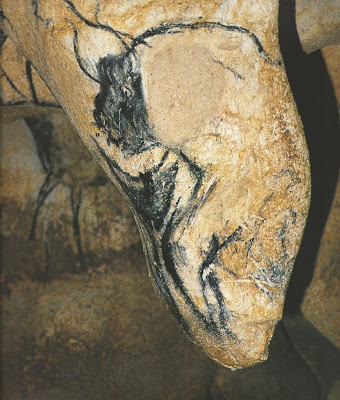www.ancientorigins.net
Saturday, June 10, 2017
A PALEOLITHIC BUFFALO WOMAN?
Chauvet cave,
www.pinterest.com,
public domain.
On December
3, 2016, I posted a column about an article in the December 2016 issue of
Scientific American magazine. Written by Julien d'Huy, and titled The Evolution
of Myths, this article traced back the origins of the Greek Polyphemus myth to
the Paleolithic of 30,000 to 15,000 years ago. D'Huy illustrated this with the
figure from the cave of Les Trois Freres of the "shaman" or buffalo
dancer figure surrounded by bison. Intrigued, I wrote the author and asked
about the concept of the Pied Piper in mythology, and whether that would fall
in the same myth family? I published his answer in my column on April 29, 2017
- he was uncertain but did not believe that the Pied Piper myth had anything
close to the necessary depth in time to be pertinent to this cave painting.
Vertical bison,
Chauvet cave,
www.pinterest.com,
public domain.
D'Huy's
analysis traced the Polyphemus myth through space as well as time, indicating
that it had reached North America in the Paleolithic period and had evolved
into an explanation of the coming of the buffalo. He even related a Blackfoot
version that involved Trickster Crow hiding a herd of buffalo in a cave, but
two hunters outwitted him and freed the buffalo. (d'Huy 2016) For other peoples
of North America the trickster who hid the buffalo was Coyote. For the Lakota
people, however, the buffalo were brought to the people by Buffalo Woman, or
White Buffalo Maiden.
White-Buffalo Woman,
www.ancientorigins.net,
public domain.
"Centuries ago, the Sioux
roamed the Paha Sapa or Black Hills. Legends have grown around the now famous
vacation land of America in the State of South Dakota, and to this day the
legends are still told.
The wind cave, where Wind Cave
National Park is located, was a sacred cave where the buffalo lady dwelt. At
first the Sioux feared the cave because they thought a giant lived in it. They
thought that the wind which blew in and out of the mouth of the cave was caused
by a giant breathing. This giant invoked the providence of the Great Spirit to
give him knowledge of the mysterious hidden powers of Mother Nature that lurked
in the cave the Indians feared.
One day, a medicine man stood at the
mouth of the cave pondering, and suddenly, a vision appeared to him. A young
Indian maiden told him she was the immortal buffalo lady from below the earth.
The buffalo lady told the medicine
man to tell his people that the cave was one of the sacred places of the Paha
Sapa. She said, 'Tell your people to come to this cave and offer gifts and
tokens by dropping them into the sacred cave. By your offerings the Great
Spirit will provide your temporal wants by providing great herds of buffalo for
your livelihood.'"
(Wikipedia)
Close-up,
White-Buffalo Woman,
www.ancientorigins.net,
public domain.
Another
version of the story can be found on the website of the American Indian College
Fund. It relates
that many years ago "the seven
sacred council fires of the Lakota Sioux came together and camped during the summer.
The people were starving because there was no game. Two young men went out to
look for food for their people in the Black Hills of South Dakota.
Along the way, a beautiful young
woman dressed in white appeared to them, saying, 'Return to your people and
tell them I am coming.' When she
presented herself to the Lakota people with the sacred pipe which showed how
all things were connected, she taught them the mysteries of the earth. She
taught them to pray and follow the proper path while on earth.
Then, before leaving, she rolled
upon the earth four times, changing color each time, turning into a white
buffalo calf before she disappeared. As she left, great herds of buffalo
surrounded the camps. After that day the Lakota honored their pipe and the buffalo
were plentiful." (collegefund.org)
Deep inside
Chauvet Cave there is a painting that seems to illustrate the transformation of
a buffalo into a woman and vice versa. It could be possible that this
illustrates some variant of the Buffalo Woman myth. Drawn on a downward
projecting stalactite is a frontal view of the lower half of a nude woman's
figure from the pubic triangle on down. "There
are also a couple of good examples of the hybrid figure of a bison-woman, such
as the famous image from Chauvet, in France. This black painting features the
detailed head of a bison on top of the lower half of a female body (she is nude
and her pubic triangle has been emphasized by the artist)." (Von
Pezinger 2016:91)
Chauvet Buffalo Woman,
pinterest.com,
public domain.
However a
closer look reveals that her left leg is the front leg of a buffalo (whose head
is right above the woman's pubic triangle). Even more interestingly, the
woman's right leg appears to also be the leg of a lion drawn on the stalactite.
Whether or not this composition was meant to actually illustrate some Paleolithic
version of the Buffalo Woman myth, it certainly does a great job of conveying
the idea of animal to human transformation.
NOTE:
Images used in this column were retrieved from the Internet with a search that
included the phrase Public Domain. If any of these images were not intended to
be public domain I apologize for their use, and will be happy to correct my
error if so informed.
REFERENCES:
d'Huy,
Julien
2016 The Evolution of Myths, pages 62-69, Scientific American, vol. 315, No. 6,
Dec. 2016.
Von
Petzinger, Genevieve,
2016 The First
Signs, Unlocking the Mysteries of the World's Oldest Symbols, Atria Books,
New York, London
http://collegefund.org/blog/the-meaning-of-the-sacred-white-buffalo/
http://wiki.olc.edu/index.php/Lakota_Stories
www.ancientorigins.net
www.ancientorigins.net
Labels:
bison,
Buffalo Woman,
Chauvet,
Lakota,
mythology,
paleolithic,
paleolithic art,
pictograph,
rockart
Subscribe to:
Post Comments (Atom)









No comments:
Post a Comment